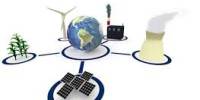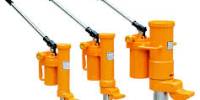Introduction
This report is limited to a very simple overview of how smart meters work, and the other parts of the communication system that are required for them to transmit information on energy usage within a home or other building of the organization and domestic. Often called ‘advanced metering infrastructure or AMI’, smart meters are a part of an overall system that includes a) a mesh network or series of wireless antennas at the neighborhood level to collect and transmit wireless information from all the smart meters in that area back to a utility.
The mesh network (sometimes called a distributed antenna system) requires wireless antennas to be located throughout neighborhoods in close proximity to where smart meters will be placed. Often, a municipality will receive a hundred or more individual applications for new cellular antenna service, which is specifically to serve smart meter technology needs. The communication network needed to serve smart meters is typically separate from existing cellular and data transmission antennas (cell tower antennas). The mesh network (or DAS) antennas are often utility-pole mounted. This part of the system can spread hundreds of new wireless antennas throughout neighborhoods.
Smart meters are a new type electrical meter that will measure our energy usage, like the old ones do now. But, it will send the information back to the utility by wireless signal (radiofrequency/microwave radiation signal) instead of having a utility meter reader come to the property and manually do the monthly electric service reading. So, smart meters are replacements for the older ‘spinning dial’ or analog electric meters. Smart meters are not optional, and utilities are installing them even where occupants do not want them.
In order for smart meters to monitor and control energy usage via this wireless communication system, the consumer must be willing to install power transmitters inside the home. If power transmitters are not installed by the homeowner, or otherwise mandated on consumers via federal legislation requiring all new appliances to have power transmitters built into them, then there may be little or no energy reporting nor energy savings.
Smart meters could also be installed that would operate by wired, rather than wireless means. Shielded cable, such as is available for cable modem (wired internet connection) could connect smart meters to utilities. However, it is not easy to see the solution to transmit signals from power transmitters (energy use for each appliance) back to the utility.
Collector meters are a special type of smart meter that can serve to collect the radiofrequency/microwave radiation signals from many surrounding buildings and send them back to the utility. Collector meters are intended to collect and re-transmit radiofrequency information for somewhere between 500-5000 homes or buildings. They have three operating antennas compared to two antennas in regular smart meters. Their radiofrequency microwave emissions are higher and they send wireless signal much more frequently. Collector meters can be place on a home or other building like smart meters, and there is presently no way to know which a homeowner or property owner might receive.
Answer to the Question No 1
Organizational Adaption
To answer this question I have select a company naming BC Hydro Ltd for the analysis of this section. The analysis is as follows.
The Need for Smart Metering
Home electronics, consumer products, and manufacturing automation are just a few examples of how technology has advanced, leading to more electricity use than ever before. The electricity system that supplies the energy to support this demand hasn’t kept pace. For example, meters—the devices that measure how much electricity customers are using—have not fundamentally changed since the 1950s. In fact, the electro-mechanical meter is becoming obsolete and will soon no longer be manufactured.
Today, BC Hydro’s meters provide a one-way flow of information (from the customer to the utility) that is very basic and not timely. For example, residential and commercial customers might be surprised to learn that BC Hydro does not know of outages until, and unless, customers call to tell us the power is out.
The electricity system must be updated to ensure that BC Hydro can continue to provide customers with safe and reliable electricity. Modernizing British Columbia’s electricity system will also ensure that advances in technology can be accommodated. Without new investment in technology and systems the 20th century electricity system will be unable to support 21st century innovations such as solar panels, electric vehicles and increased customer service options. Utilities around the world are upgrading their electricity systems and adopting smart meters to enhance customer service, improve reliability and make their operations more efficient. By 2015, 250 million smart meters will be installed worldwide. In short, investing in smart metering infrastructure is as important as renewing and reinvesting in our dams and generating facilities. Over the next three years, BC Hydro will be investing $2 billion per year to build and renew dams, generating facilities, and transmission and distribution networks to ensure a safe and reliable supply of power continues to flow to B.C.’s homes and businesses. A key component of this investment is the Smart Metering Program.
BENEFITS
BC Hydro’s Smart Metering Program delivers substantial benefits to customers.
Specifically, the program will:
• Improve safety and reliability;
• Enhance customer service;
• Reduce electricity theft;
• Improve operational efficiency and reduce wasted electricity;
• Support greater customer choice and control; and
• Help modernize British Columbia’s electricity system.
Improve Safety and Reliability
Keeping customers’ power on requires BC Hydro to dispatch crews day and night, under all types of weather conditions to search for, assess, and repair faults on the electricity system. The current metering infrastructure does not provide any residential customer outage information to BC Hydro. In fact, BC Hydro is not aware of outages until customers call in to inform us that the power is out. Due to this lack of detailed and specific outage information, field crews engage in significant travel to identify the location and cause of an outage, increasing personal risk as well as delaying restoration times. During storm season, the outages are frequently at multiple locations and the risk is even higher due to the need to drive and fly under adverse conditions. In addition, theft of electricity is occurring in increasingly dangerous ways, posing major safety risks to the general public, first responders and BC Hydro employees through the threat of fire and electrocution. For example, in Surrey, approximately 50 per cent of marijuana growing operations inspected by the fire department involved diversion of electricity from BC Hydro distribution lines. Theft also causes strain on the distribution infrastructure resulting in an estimated 100 premature transformer failures a year.
The Smart Metering Program will deploy new technologies, better analysis and notification tools, and automated decision-making that will result in improved public and employee safety and shorter outage restoration times. Benefits include:
Faster outage notification
Real-time outage notification provided automatically by smart meters will serve to pinpoint problems quickly and specifically, reducing the amount of travel required under adverse conditions and accelerating the restoration process.
Reliable restoration notification
Allowing field crews to quickly confirm the outage has been addressed instead of driving along the electricity lines to look for secondary outage problems.
Reduced risk and fewer outages from electricity diversions
By helping identify potential electricity diversions in a more consistent and automated way, the Smart Metering Program will reduce safety risks and customer outages that are caused by premature transformer failures.
Enhance Customer Service
Smart meters capture more accurate and detailed electricity use information, which will result in enhanced customer service including:
More accurate meter readings
Anomalies in reported electricity use can be reconciled quickly and accurately with the use of hourly meter data rather than bi-monthly meter reads or estimated bills.
Elimination of estimated billing
With smart meters in place, customer bills will be generated from actual electricity use, not from estimated readings based on profiles.
More streamlined moving procedures
With automated meter reads available on request, customers can receive an accurate, up-to-date final bill and will no longer have to deal with transferring bill amounts when they move into or move out of a home or business.
Better informed customer service representatives
BC Hydro call centre employees will have substantially more accurate information available to address customer questions related to their bills, electricity use, or opportunities for energy savings.
Increased privacy and convenience
Customers will no longer need to provide meter readers with regular access.
Reduced onsite visits
Automated meter reading, automated connection services, and more information available for problem solving, will reduce the need for BC Hydro to send crews to customer homes and businesses resulting in direct savings that will be passed on to customers.
Answer to the Question No 2
Domestic Adaption
Smart metering has the potential to improve the services offered to consumers by introducing better tailored energy tariffs. However, it is possible that choicer and more complex tariffs could lead to customer confusion and create the potential for customers to be misled. Of gem already has a broad range of powers to tackle these issues. As smart metering is rolled out and new tariffs are developed, it will continue to keep these issues under review.
The rollout of smart metering presents significant commercial opportunities for suppliers to offer consumers new tariffs, more sophisticated energy advice and integrated energy service packages. However, consumer groups have raised particular concerns about selling during the installation process. We recognize these concerns but also believe that some marketing may deliver potential benefits to consumers. We wish to ensure that the installation visit is not used for unwelcome sales activities and are considering the coverage provided by existing protections to assess what further action we can and should take to achieve this objective.
However, we need to ensure that the installation visit can also be used to maximize the benefits that can be realized through a single visit, for example, in cases where consumers have expressed an interest in additional information or products that the supplier can provide.
Smart metering can also improve the services offered to consumers by facilitating quicker and smoother switching between suppliers and tariffs. By switching supplier, consumers can often make significant savings on their bills or obtain improved customer service. We are considering the scope for reforming existing industry processes to reduce the time that it takes to switch and to reduce errors. We are also working to ensure that smart metering does not make it more difficult to switch supplier. To prevent technical barriers to switching, we have specified the functional requirements that will be used as a basis for developing a detailed technical specification for the smart metering system. Of gem is also considering the commercial arrangements for allowing suppliers to take over existing meters as part of its ongoing review of metering arrangements.
The supplier will also need to consider how to identify the customer’s circumstances prior to switching the customer to prepayment terms. One method of doing this would be for suppliers to improve and scale up the registers of priority service customers. The visit to the customer premises to install a smart meter represents a particularly valuable opportunity for a supplier to identify consumers who may be eligible to join their Priority Services Register (PSR). However, improving the PSR alone is unlikely to ensure that customers are not switched inappropriately, in particular as a customer’s circumstances can change over time and customers may move home. Where suppliers are not aware of the customer’s circumstances, they will need to contact the customer prior to switching them to prepayment terms to identify any issues and otherwise satisfy their obligations under the domestic supply license conditions.
As noted above, currently the installation of a PPM requires a site visit. As such, customers are fully aware they have been transferred to a PPM and can be provided with information on how to use the meter at the time of installation. In the future, where a customer is switched to prepayment terms remotely, it will be necessary to notify the customer of the impending switch and make them aware of how to operate the smart meter in prepayment mode. The IHD may be one route but we currently do not believe this can be the only route to notification.
There are a number of steps that suppliers could take to identify vulnerability when considering disconnection. Ofgem has previously provided guidance on the types of proactive steps it would expect suppliers to determine the status of consumers and occupants prior to disconnection. This includes undertaking at least one personal visit to the property which is at risk of being disconnected. In addition to a site visit, other steps identified in the guidance include reviewing all the notes on the customer’s accounts to ensure that no vulnerability is recorded, ensuring that customers are not registered on their PSR and seeking senior management authorization prior to any disconnection being carried out. Such checks may also be important in ensuring more generally that the correct property is being disconnected and that there are no other factors that might militate against disconnection.
Currently, the supplier needs to visit the customer’s premises to physically disconnect supply. It is, therefore, clear to the customer that they have been disconnected. With remote disconnection and if a site visit is not required (or could take place prior to the actual disconnection) this may not be as clear. The customer may assume that there has simply been a power cut, or may be otherwise unclear what they have to do to get the supply restored.
As well as enabling remote disconnection, the meter will also provide for remote reconnection. Faster reconnection offers clear benefits to customers who can be reconnected more quickly once any debt is paid off or in cases where vulnerability is subsequently discovered. This may provide an opportunity to update the existing timeliness of reconnection provisions in the guaranteed standards of performance12 and the industry’s self regulatory Safety Net. However, there may be limitations on what can be achieved. One potential issue with gas is that there is currently a safety requirement for a purge and relight when the gas is restored, which requires the supplier to have access to the customer’s premises.
Answer to the Question No 3
Innovation
Enhance Customer Service
Smart meters capture more accurate and detailed electricity use information, which will result in enhanced customer service including:
More accurate meter readings
Anomalies in reported electricity use can be reconciled quickly and accurately with the use of hourly meter data rather than bi-monthly meter reads or estimated bills.
Elimination of estimated billing
With smart meters in place, customer bills will be generated from actual electricity use, not from estimated readings based on profiles.
More streamlined moving procedures
With automated meter reads available on request, customers can receive an accurate, up-to-date final bill and will no longer have to deal with transferring bill amounts when they move into or move out of a home or business.
Better informed customer service representatives
BC Hydro call centre employees will have substantially more accurate information available to address customer questions related to their bills, electricity use, or opportunities for energy savings.
Increased privacy and convenience
Customers will no longer need to provide meter readers with regular access.
Reduced onsite visits
Automated meter reading, automated connection services, and more information available for problem solving, will reduce the need for BC Hydro to send crews to customer homes and businesses resulting in direct savings that will be passed on to customers.
Improve Operational Efficiency and Reduce Wasted Electricity
Currently, BC Hydro transmits more electricity than needed by customers to ensure there is acceptable power quality delivered to every customer. Reducing wasted electricity benefits all customers through lower operating costs.
The amount of excess energy required can be substantially reduced with better monitoring and control over the distribution system including:
Voltage optimization
Use voltage information collected from smart meters to make existing electricity control devices (voltage regulators, capacitor banks, and transformers) along the distribution system more efficient. Simply put, less electricity will be required to be transmitted to maintain expected power quality, resulting in less electricity having to be generated or purchased, which in turn, lowers costs.
Efficiencies in meter reading
Meter sampling, distribution system maintenance, outage management, and load research— Will significantly reduce operating costs.
Today, customers have few tools to manage their electricity use because the current meters do not capture enough information.
Without specific and timely information, it is difficult for customers to take advantage of new service options or make informed decisions to actively manage electricity in their own circumstances.
Research has shown that electricity is typically not something customers regularly think about, and that increasing customer awareness by enabling them to view their own consumption in a timely manner can achieve electricity savings of up to 15 per cent.
More information and control will help customers to save money—and help to achieve BC Hydro’s goal of meeting two-thirds of incremental electricity demand through conservation by 2020.
The Smart Metering Program will enable customers to have greater choice and control of their energy use through:
• Optional in-home feedback tools—BC Hydro will provide incentives for customers to adopt market available in-home displays, programmable thermostats, and energy management software products.
• Power Smart website—Customers will also have the option of accessing their own secure consumption information through BC Hydro’s expanded Power Smart website.
• Rate Options—Smart meters capture information that will enable BC Hydro to design new rate structures that encourage conservation during peak periods, such as voluntary time-of-use. The design of these rates will involve consultation with customers and will be subject to review and approval by the BC Utilities Commission.
BC Hydro’s electricity system, including the current base of electromechanical meters, has changed very little over the past 50 years. These older style meters are becoming obsolete, as meter vendors switch to producing smart meters.
Upgrading to a smart metering system is a key foundational step in modernizing BC Hydro’s overall electricity system.
Additional measurement points throughout the electricity system combined with the ability to measure electricity to and from a customer site will enable:
• Support for new customer applications—Advanced telecommunications infrastructure will support advanced electricity system functions and emerging applications like customer generation and micro grids.
• Support for large-scale clean energy initiatives—Implementation of smart metering and network operations functions will help BC Hydro to manage new uses for the electricity system such as electric vehicles, electrification of public transportation, community-based generation, and integration of renewable fuel sources. For example, with a more modern electricity system, customers who invest in solar panels, or other clean sources of electricity, could sell excess power back to BC Hydro, or draw electricity from their electric vehicles during a power outage.
Quantified Benefits
The Smart Metering Program business case includes approximately $1.6 billion in quantified benefits (present value), to be realized over 20 years. These benefits are attributed to four primary areas including:
Operational Efficiencies
More efficient use of distribution assets and streamlining of business processes, thereby reducing operational and future capital expenses;
Energy Savings
Lower electricity use through improved distribution system control, efficiencies and reduced consumption by customers;
Revenue Protection
Includes both recovery of revenue and prevention of future potential revenue loss through reduced theft; and
Capacity Savings
Lower electricity used at certain key periods, which reduces peak demand and capacity constraints.
Almost 80 per cent of the quantified benefits delivered through the Smart Metering Program result from operational efficiencies within BC Hydro. If customers take advantage of the conservation tools offered through the program, the overall benefits increase significantly.
Benefits Realization
The Smart Metering Program is a large and complex project designed to deliver significant benefits from across several business groups at BC Hydro. The benefits described in this business case pay for the investment in the program. BC Hydro is implementing a formal benefit realization framework, base-lined with the benefit streams identified in this business case, to ensure accountability and transparency in the measurement and reporting of the benefits over time.
Security, privacy and safety have been considered key priorities throughout the development of the Smart Metering Program. The program redefines many of the existing business processes—and introduces new ones—requiring that security, privacy and safety are embedded in each and every aspect. The basic principles of Security-by-Design, Privacy-by-Design and Safety by-Design have been incorporated throughout the planning of the program. Each of these disciplines is also intrinsically linked; for example, ensuring a security objective is achieved also enhances safety and privacy.
Answer to the Question No 4
Roll Out
In 2004, the Essential Services Commission of Victoria, Australia (ESC) released its changes to the Electricity Customer Metering Code and Procedure to implement its decision to mandate interval meters for 2.6 million Victorian electricity customers.
The ESC’s Final Paper titled “Mandatory Rollout of Interval Meters for Electricity Customers” foreshadowed the changes to be implemented and contained the rollout timetable requiring interval meters to be installed for all small businesses and residences. The rollout commenced in mid-2009 and is forecast to be completed by the end of 2013.
In 2009 the Victorian Auditor General undertook a review of the program and found that there were “significant inadequacies” in advice to government and that project governance “has not been appropriate”.
The Victorian Government has subsequently announced that there will be a moratorium on the introduction of Time-of-Use tariffs. Meters installed in Victoria have been deployed with limited smart functionality that is being increased over time. 30-minute interval data is available, remote cut-off and start-up emerging is available, and the Home Area Network will be available for households in 2012.
In May 2010 it was reported that the program was expected to cost $500 million more than originally estimated by proponents, with a total cost of $1.6 billion.
In November 2010 the Victorian Labor Party was voted out of state government. The incoming coalition stated that the meter program would be reviewed and the Auditor General’s recommendations implemented specifically commenting on program governance, customer data protection, and cost recovery. In January 2011 the Energy Minister, Michael O’Brien, said he was not ruling out a suspension of the program.
The Commonwealth issued a Joint Communiqué at the Council of Australian Governments meeting in Canberra on 17 February 2006 committing all governments to the progressive rollout of smart metering technology from 2007.
Despite its simplicity, a uniform wireless smart meter network is actually more expensive to run and offers few or no revenue opportunities to a utility to offset the cost of installation. Such networks are the usual cause of “smart meter backlash” because they implement peak prices without giving the consumer any new control or monitoring options. The typical low-end wireless “solution” involves reading a meter every 15 minutes – not often enough to help the customer manage their power use, because they cannot turn a switch and wait over 30 minutes through two sampling periods to see if it has actually made a difference. The same criticism applies to low-end solutions deployed prior to standardization.
Fibre and other wired builds are effective not only because of their potential telecom and advanced service revenues, but because the rate of sampling of overall power use is under a second, meaning you can tell instantly at the control panel exactly how much or how little any given device is using. Thus, customers can spot wasteful or leaky devices or habits and adjust/replace devices. Software or third party services can watch usage patterns in detail, and even micro-variations in current, that reveal electrical problems (even fires) early and which allow programmed responses to human activity (the lights dim when you leave, brighten when you arrive & radio comes on) because the services see exactly what users really do when entering or leaving a room. There’s plenty of bandwidth to sell or allocate to security or medical devices. Home monitoring and control systems can be installed compatible with the metering simultaneously, increasing perception of benefits with the costs.
Smaller North American utilities such as Bristol Virginia Utilities and Chattanooga, TN’s EPBfi have deployed advanced metering as part of town wide fibre builds with no smart meter backlash whatsoever. They rejected wireless technologies specifically for the lack of economic development value and customer resistance.
There are questions whether electricity is or should be primarily a “when you need it” service where the inconvenience/cost-benefit ratio of time shifting of loads is poor. In the Chicago area Commonwealth Edison ran a test installing smart meters on 8,000 randomly selected households together with variable rates and rebates to encourage cutting back during peak usage. In the Crain’s Chicago Business article Smart grid test underwhelms. In pilot, few power down to save money. it was reported that fewer that 9% exhibited any amount of peak usage reduction. and that the overall amount of reduction was “statistically insignificant”. This was from a report by the Electric Power Research Institute, a utility industry think tank who conducted the study and prepared the report. Susan Satter, senior assistant Illinois attorney general for public utilities said “It’s devastating to their plan……The report shows zero statistically different result compared to business as usual.
Industry Standards Development
BC Hydro is participating in the National Electric Energy Testing Research and Applications Center (NEETRAC), testing and developing meter service connect/disconnect standards with respect to performance and safety. As part of BC Hydro’s metering system procurement process vendors must provide formal documentation related to their compliance with the testing requirements and acceptance criteria of NEETRAC. Further, BC Hydro is working as members of an American National Standards Institute committee on advancing service connect/disconnect standards. BC Hydro’s commitment to service switch safety will enhance the safety of both customers and workers.
Solution Integration
In addition to the overall smart metering system, the Smart Metering Program is responsible for the business environment that supports smart metering including implementation of new business software applications, changes to existing information systems, enhanced data warehouse and analytics capabilities, and all of the business transformation activities that will help
BC Hydro adapt to the new technologies and systems. Specific elements of scope include:
• Meter Data Management System—A software application that stores, validates, edits and analyses meter reading data prior to releasing it for integration into other BC Hydro operational systems such as customer billing, load forecasting and outage management.
• Interfaces and Integration—This systems integration work involves modifying existing applications to handle the enhanced automated meter reading information, and building interfaces between new and existing enterprise applications to support BC Hydro’s end-to-end business processes.
• Business Transformation—The major elements of business transformation work involve development of new and modified business processes, design of organizational and job changes, rollout of training and knowledge management programs, employee engagement to facilitate cultural change, and effective transition to business operations for ongoing work.
Conclusion
Since the inception of electricity deregulation and market-driven pricing throughout the world, utilities have been looking for a means to match consumption with generation. Traditional electrical and gas meters only measure total consumption, and so provide no information of when the energy was consumed at each metered site (market use rates are readily available to utilities however). Smart meters provide a way of measuring this site-specific information, allowing price setting agencies to introduce different prices for consumption based on the time of day and the season.
Utility companies propose that from a consumer perspective, smart metering offers a number of potential benefits to householders. These include, a) an end to estimated bills, which are a major source of complaints for many customers b) a tool to help consumers better manage their energy use – stating that smart meters with a display outside their homes could provide up-to-date information on gas and electricity consumption in the currency of that country and in doing so help people to manage their energy use and reduce their energy bills and carbon emissions. Proponents assert that in some countries[which?] there are potential social benefits of smart metering — for example, the potential for telehealth and social care services that can facilitate health services and enable consumers to live independently for longer.[citation needed] Such monitoring would require extensive data collection and analysis, which is not now performed. There is also the opportunity to target assistance at vulnerable and low income consumers more effectively and end disconnection for electricity customers. These potential benefits have not been provided.
Electricity pricing usually peaks at certain predictable times of the day and the season. In particular, if generation is constrained, prices can rise if power from other jurisdictions or more costly generation is brought online. Proponents assert that billing customers by time-of-day will encourage consumers to adjust their consumption habits to be more responsive to market prices and assert further, that regulatory and market design agencies hope these “price signals” could delay the construction of additional generation or at least the purchase of energy from higher priced sources, thereby controlling the steady and rapid increase of electricity prices. There are some concerns, however, that low income and vulnerable consumers may not benefit from intraday time-of-use tariffs.
Ironically making an industry-stated primary objective mute, when questioned about potential changes to time-of-day rates, a utility representative in Florida denied such intentions when he stated, “There are no plans to implement any price and he added that, since they are regulated by the state government, any such change would be subject to regulatory approval after required public hearings.
Smart metering offers potential benefits to utility companies in that they will be able to eliminate many jobs, but there are concerns that many of the “benefits” proponents cite for consumers, not only will fail to be realized, but to the contrary, could increase costs to the consumers.
















